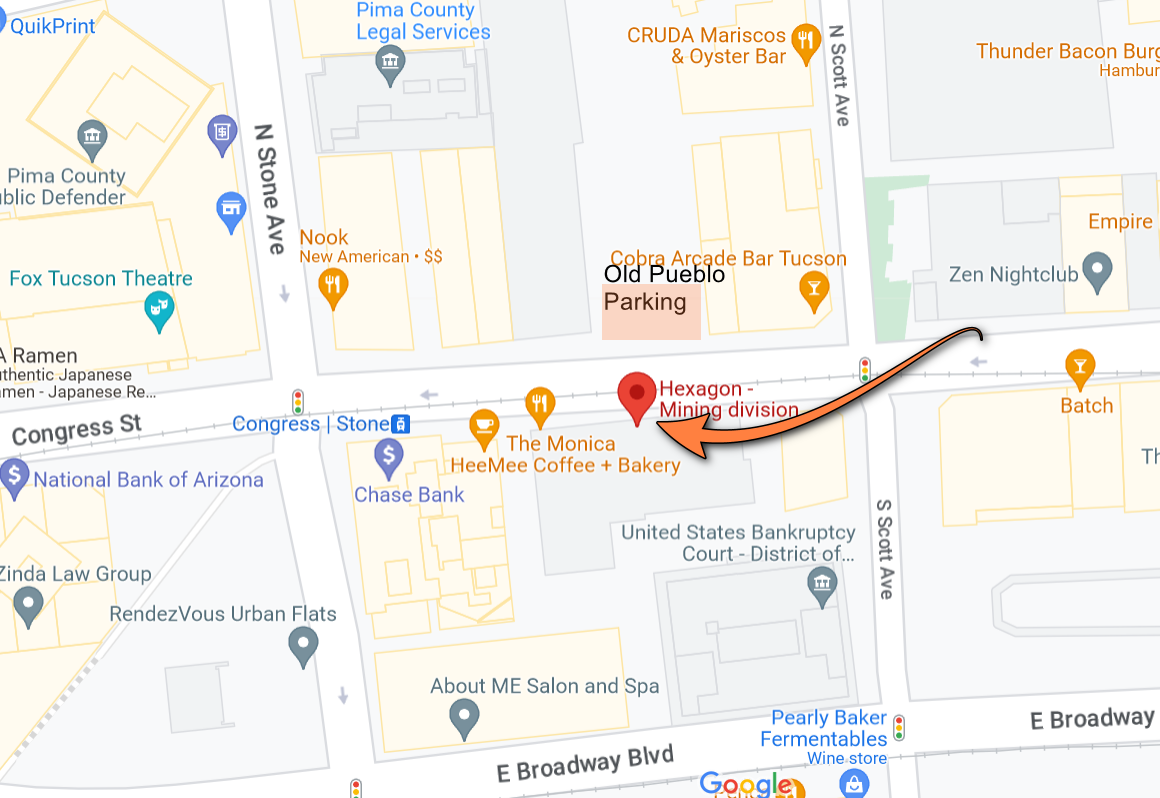Arizona Geological Society
2023 Speaker Series
Tuesday, 7 March 2023 | 6:00 - 8:30 PM
Location: Hexagon Mining Division Office
40 East Congress Street, Suite 150, Tucson, Arizona 85701
Parking: On the street or parking garage (Old Pueblo Parking)
EVENT: Social Hour (6 - 6:45 PM) | Pizza (6:45 - 7:15 PM) | Presentation (7:15 PM)
For those unable to attend, the remote broadcast begins at 7:15 PM. No registration or fee to attend remotely.
Microsoft Teams meeting
Join on your computer, mobile app or room device
Click here to join the meeting
Meeting ID: 336 984 985 140
Passcode: pBEeeh
Download Teams | Join on the web
Or call in (audio only)
+41 43 210 57 19,,474897326# Switzerland, Zurich/Zürich/Zurigo (Zurich)
Phone Conference ID: 474 897 326#
AGS Executive Committee thanks Hexagon for generously providing the venue and drinks.
Magmatism and Characteristics of Supergene and Hypogene Alteration-Mineralization of the Lone Star Porphyry Copper Deposit, Safford District, Arizona
by Ralph J. Stegen and David B. Parker
Freeport-McMoRan Exploration (Retired), Tucson Arizona
Abstract: The Lone Star porphyry copper deposit is located in the Transition Zone between the Basin and Range and Colorado Plateau Provinces in southeastern Arizona. The deposit is hosted by Late Cretaceous andesite lavas and fragmental pyroclastic flows of the Safford Volcanics. Near the center of the deposit, cone-shaped bodies of felsic tuffs and heterolithic breccia comprise a diatreme complex intruded by swarms of sheeted dikes. The earliest dikes are dacitic that both cut and grade upward into tuffaceous units of the diatreme. The dacite dikes are cut by quartz latite dikes that are in turn cut by quartz monzonite porphyry dikes. Square quartz porphyry (quartz monzonite) dikes cut all of the above units. New U-Pb zircon ages of dacite in the diatreme are 58 Ma, supplemented by dacite, quartz latite, and quartz monzonite dikes that yield 56-55 Ma ages, and the post-hypogene square quartz porphyry dikes at 55-54 Ma bracket the age of the deposit. A mid-Tertiary erosion surface formed, and lava flows of basaltic andesite dated at 24 Ma were deposited on the unconformity. The deposit is upright and is cut by northeast striking faults with steep dips that contain dikes and veins. Basin and Range faults with northwest strikes offset the Neogene andesite and localized deposition of Miocene-Pliocene conglomerate and lacustrine deposits in the Safford Valley west of the deposit.
Hypogene alteration is widespread and has similar characteristics deposit-wide. The earliest K-silicate alteration is the pervasive replacement of Cretaceous andesite by biotite and in deeper areas by albite and magnetite. Early veins of quartz and quartz-magnetite-biotite cut the biotitic alteration. Cutting and offsetting these are K-silicate veins containing quartz, chalcopyrite, pyrite, magnetite, and molybdenite with K-feldspar, quartz, and/or biotite halos. Quartz-sericite-pyrite veinlets and envelopes form an expansive stockwork in the upper parts of the deposit.
Results from on-going exploration drilling indicate that copper mineralization within K-silicate alteration forms an inverted cup-shaped shell that is elongated northeast-southwest with thick-walled limbs. The shell is up to 3.3 by 2.7 km in area using a >0.3% Cu value. The majority of the copper grades within the shell range from 0.3 to 0.5% except for discrete zones in the northeastern and southwestern areas that have grades of 0.7 - 0.9% Cu.
Supergene mineralization consists of leached capping, oxide copper, and an enriched blanket developed in the apical part of the copper shell. Hematitic leached capping is localized within the diatreme and large felsic dikes. Chrysocolla and black oxide mineraloids comprise the oxide copper deposit situated just beneath the unconformity with overlying andesitic flows. Below the oxide copper deposit is a chalcocite enriched mass that transitions at depth into the hypogene copper mineralization. The leached capping and oxide copper deposit is interpreted to have formed prior to late Oligocene time by the in-situ oxidation of chalcopyrite in andesite. Concurrent with oxide copper formation was the initial cycle of leaching and enrichment that formed a chalcocite deposit in diatreme and dike rocks. Neogene extension and erosion of the Oligocene basalt cap rocks resulted in the subsequent partial leaching of the chalcocite bodies and formation of chalcocite enrichment at depth.
 Bio: Ralph Stegen retired in 2020 from Freeport-McMoRan Exploration where he was a Vice President of Mine Site Exploration responsible for the exploration and resource modeling functions at their operating and closed mines in North and South America and Africa. Prior to this he was chief geologist at their Morenci and Tyrone mines and before worked as a project geologist doing core logging, resource modeling, and surface and pit mapping at Freeport's various mines.
Bio: Ralph Stegen retired in 2020 from Freeport-McMoRan Exploration where he was a Vice President of Mine Site Exploration responsible for the exploration and resource modeling functions at their operating and closed mines in North and South America and Africa. Prior to this he was chief geologist at their Morenci and Tyrone mines and before worked as a project geologist doing core logging, resource modeling, and surface and pit mapping at Freeport's various mines.
Before working for Phelps Dodge and Freeport, he worked for Noranda underground at Park City and did exploration at Marysvale and Leadville. He also worked at Questa for Molycorp and with Tenneco at Goldstrike and various projects in Nevada. His first geology position was with the Utah Geological Survey.

Hexagon Mining Division Office - 40 East Congress Street,
Suite 150, Tucson, Arizona 85701